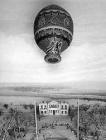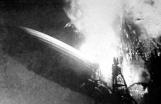1
The Montgolfier brothers' balloon
1789
Versailles, France

2
Hailing from Vidalon-lès-Annonay, France, paper manufacturer Joseph-Michel Montgolfier and his brother Jacques-Étienne were both fascinated by the fact that smoke rises, and they discovered that heat could make a sheet of paper float upward. They refined their experiments to the point that, on September 19, 1783, in Versailles, they succeeded in making a hot-air balloon rise, carrying in its wicker basket a duck, a rooster and a sheep, an accomplishment witnessed by King Louis XVI.
On November 21, 1783, Pilâtre de Rosier and the Marquis d'Arlande soared above Paris for 28 minutes. Louis XVI later conferred titles of nobility on the Montgolfier brothers for their invention. The following December, Jacques Charles and Nicolas Robert also flew in a balloon whose silk envelope was inflated with hydrogen rather than hot air.
3
The Giffard dirigible
1852

4
The 43-metre-long airship which Jules Henri Giffard (1825-1882) sent aloft on September 24, 1852, was equipped with a propeller driven by a 3 HP steam engine. Leaving from the Paris hippodrome, the airship managed to fly over a small part of the city, but at no more than five kilometres an hour.
5
German inventor Count Ferdinand von Zeppelin
1900

6
The first triumphs of rigid airships are well known in aviation circles. On July 2, 1900, Count Ferdinand von Zeppelin flew the LZ-1 for more than 15 minutes with five people on board, marking the beginning of a long adventure. Zeppelin's influence was so great that people would come to speak of ?zeppelins? rather than of airships. These aircraft consist of a skeleton of metal alloy rings and girders, and the resulting structure is covered with a fabric envelope.
7
The Hindenburg disaster
1937
Lakehurst, New Jersey, USA

8
Travel by airship was often foolhardy and sometimes disastrous. Airships such as the Dixmude, the R-34, the USS Shenandoah and the Italia were all destroyed in accidents. The first of these, the Dixmude, exploded in the middle of the night of December 21, 1923, while flying over the Mediterranean near Sicily in turbulent skies. In 1919, the R-34 had already made news by making the return trip between East Fortune near Edinburgh, Scotland, and New York. In January 1921, the R-34 crashed as a result of fog. The USS Shenandoah, which used helium instead of hydrogen, was the first airship built entirely in the United States. It crashed in Ohio on September 3, 1925. The last of these, the Italia, crashed at the North Pole in May 1928. In the end, only the Germans continued to fly airships successfully. Meanwhile, airplanes were becoming faster and able to fly over longer distances. The Hindenburg exploded in 1937 in Lakehurst, New Jersey, USA.
9
Hangars
1926
Howden, England

10
On April 6, 1926, the members of the R-100 design team moved to Howden, to facilities that had been built in 1916 and abandoned in 1921. When the company inherited the site in 1925, it was in a sorry state, and it would take a year to turn it into a respectable aerospace facility. The original construction hangars were located five kilometres from the village of Howden. Next to them, the company built a hydrogen plant, along with around 20 small houses for employees. Despite being too narrow for the construction of these great aerial giants, the hangars were, at the time, the world's largest, measuring 228.6 metres long by 45.7 metres wide.
11
Barnes Wallis, designer of the R-100 airship
1940

12
Creation of the plans for the R-100 ?capitalist? airship was entrusted to Vickers employee Neville Barnes Wallis. Born in 1887 in Ripley, Derbyshire, this physician's son was recruited by Vickers to design airships. With H.B. Pratt, he designed the R-9, R-23 and R-26. He was the chief engineer of the R-80 project and would go on to design Wellington bombers. The first, highly theoretical works he undertook began in Vickers' offices in Westminster in 1924. A few months later, the plans were drawn in Crayford, Kent. This called for a large number of calculations, but as computers had not yet been invented, the designers had to rely on a team of so-called ?calculators.?
13
Rolls-Royce engine
1929
Howden, England

14
The airship was propelled by six Rolls-Royce Condor IIIB 12-cylinder, 700 HP diesel engines. The company ended up changing its mind about the engines several times. At first, it experimented with hydrogen- and kerosene-powered engines, but soon realized that developing these engines would put the company behind schedule. They therefore opted for diesel engines. However, after six months, the directors concluded that the engines were much too heavy, so they turned to the petrol engines used in aviation. They were housed in pairs in three gondolas that hung from the R-100 outside the airship's metal structure to avoid all contact with the highly flammable hydrogen. The reconditioned Rolls-Royce engines were fitted with reversing capability, a considerable advantage over the R-101, particularly when the airship is moored or preparing to moor.






